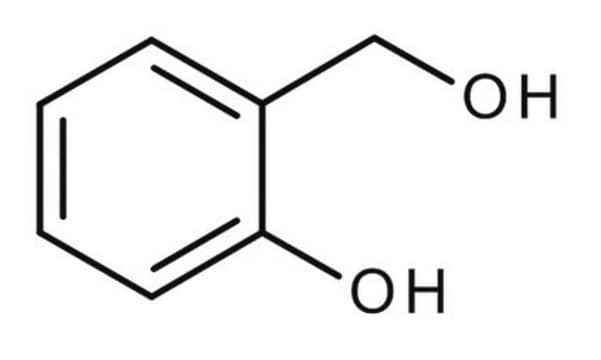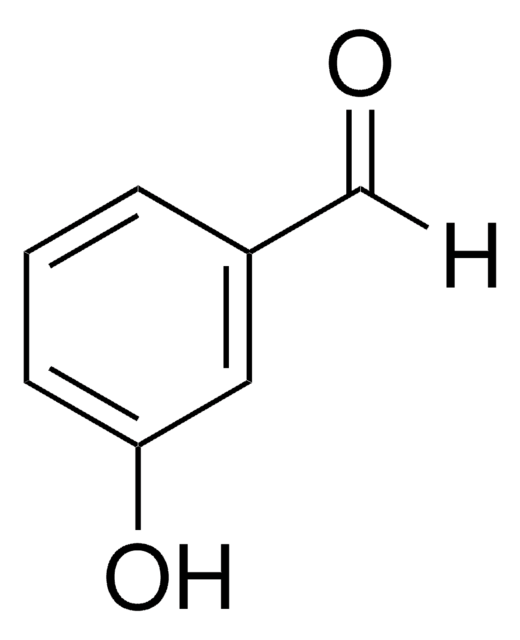166952
2-Hydroxybenzyl alcohol
99%
Synonym(s):
Salicyl alcohol, Saligenin
Sign Into View Organizational & Contract Pricing
All Photos(1)
About This Item
Linear Formula:
HOC6H4CH2OH
CAS Number:
Molecular Weight:
124.14
Beilstein:
1907195
EC Number:
MDL number:
UNSPSC Code:
12352100
PubChem Substance ID:
NACRES:
NA.22
Recommended Products
Assay
99%
form
solid
mp
83-85 °C (lit.)
solubility
ethanol: soluble 5%, clear to very slightly hazy, colorless to light yellow
functional group
hydroxyl
SMILES string
OCc1ccccc1O
InChI
1S/C7H8O2/c8-5-6-3-1-2-4-7(6)9/h1-4,8-9H,5H2
InChI key
CQRYARSYNCAZFO-UHFFFAOYSA-N
Looking for similar products? Visit Product Comparison Guide
Related Categories
General description
2-Hydroxybenzyl alcohol participates in the selective ring opening reaction of 4H-1,3,2-benzodioxasilines.
2-Hydroxybenzyl alcohol can be used as a coupling reagent to synthesize O-heterocycles.
2-Hydroxybenzyl alcohol can be used as a coupling reagent to synthesize O-heterocycles.
Application
2-Hydroxybenzyl alcohol was used in gastrodin production via biotransformation by cultured cells of Aspergillus foetidus and Penicillium cyclopium.
Storage Class Code
11 - Combustible Solids
WGK
WGK 3
Flash Point(F)
Not applicable
Flash Point(C)
Not applicable
Personal Protective Equipment
dust mask type N95 (US), Eyeshields, Gloves
Choose from one of the most recent versions:
Already Own This Product?
Find documentation for the products that you have recently purchased in the Document Library.
Customers Also Viewed
Linlin Fan et al.
Applied biochemistry and biotechnology, 170(1), 138-148 (2013-03-14)
The objective of this work was to take advantage of the resting cells of suitable fungus as an in vitro model to prepare gastrodin from p-2-hydroxybenzyl alcohol (HBA), which mainly exists in the metabolites of the plant Gastrodia elata Blume.
M Brückmann et al.
Insect biochemistry and molecular biology, 32(11), 1517-1523 (2003-01-18)
Larvae of a number of chrysomelid leaf beetles sequester phenol glucosides such as salicin from their food plants, i.e. Salix and Populus spp. Salicin is hydrolyzed in the glandular reservoir of the defensive glands. The resulting salicyl alcohol (saligenin) is
Seung-Heon Yoon et al.
Carbohydrate research, 339(8), 1517-1529 (2004-06-05)
Beta-Salicin is a naturally occurring glycoside found in the bark of poplar and willow trees. Ancient man used it as an analgesic and antipyretic. It has a D-glucopyranose unit attached by a beta-linkage to the phenolic hydroxyl of salicyl alcohol.
Fernando A Genta et al.
Journal of insect physiology, 52(6), 593-601 (2006-04-08)
Tenebrio molitor larvae were successfully reared free of cultivatable gut lumen bacteria, yeasts and fungi using two approaches; aseptic rearing from surface sterilized eggs and by feeding larvae with antibiotic-containing food. Insects were reared on a rich-nutrient complete diet or
Swati J Modi et al.
Journal of chromatography. A, 1118(1), 125-133 (2006-03-21)
On-line in vitro microdialysis (MD) sampling followed by HPLC separation and UV absorbance detection (HPLC-UV) was used to monitor carbohydrate enzyme systems. Fundamental parameters (i.e., K(m) and V(max)) of hydrolysis reactions of 4-nitrophenyl-beta-D-glucopyranoside, 4-nitrophenyl-beta-d-galactopyranoside, and 4-nitrophenyl-beta-D-xylopyranoside were determined for a
Our team of scientists has experience in all areas of research including Life Science, Material Science, Chemical Synthesis, Chromatography, Analytical and many others.
Contact Technical Service











